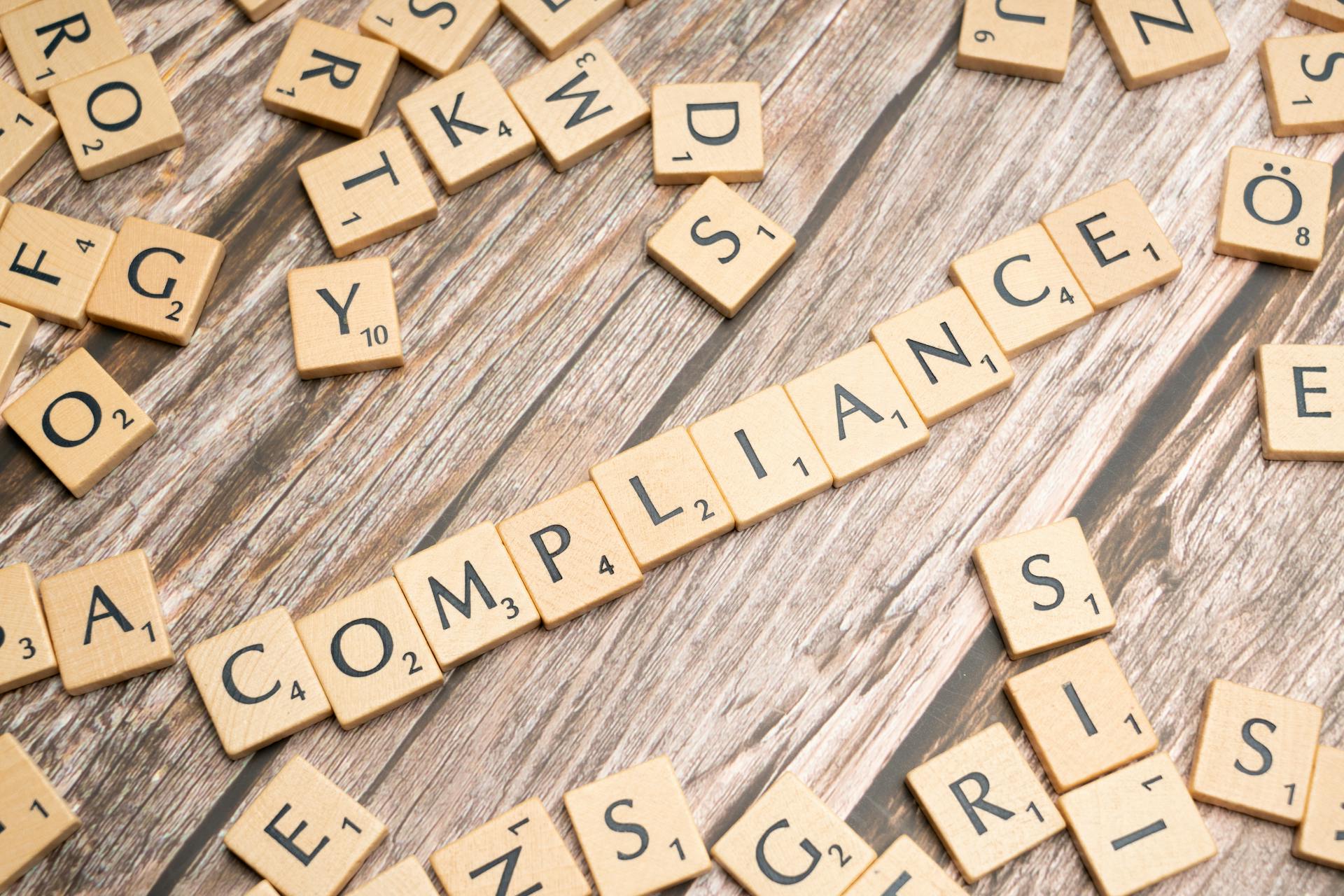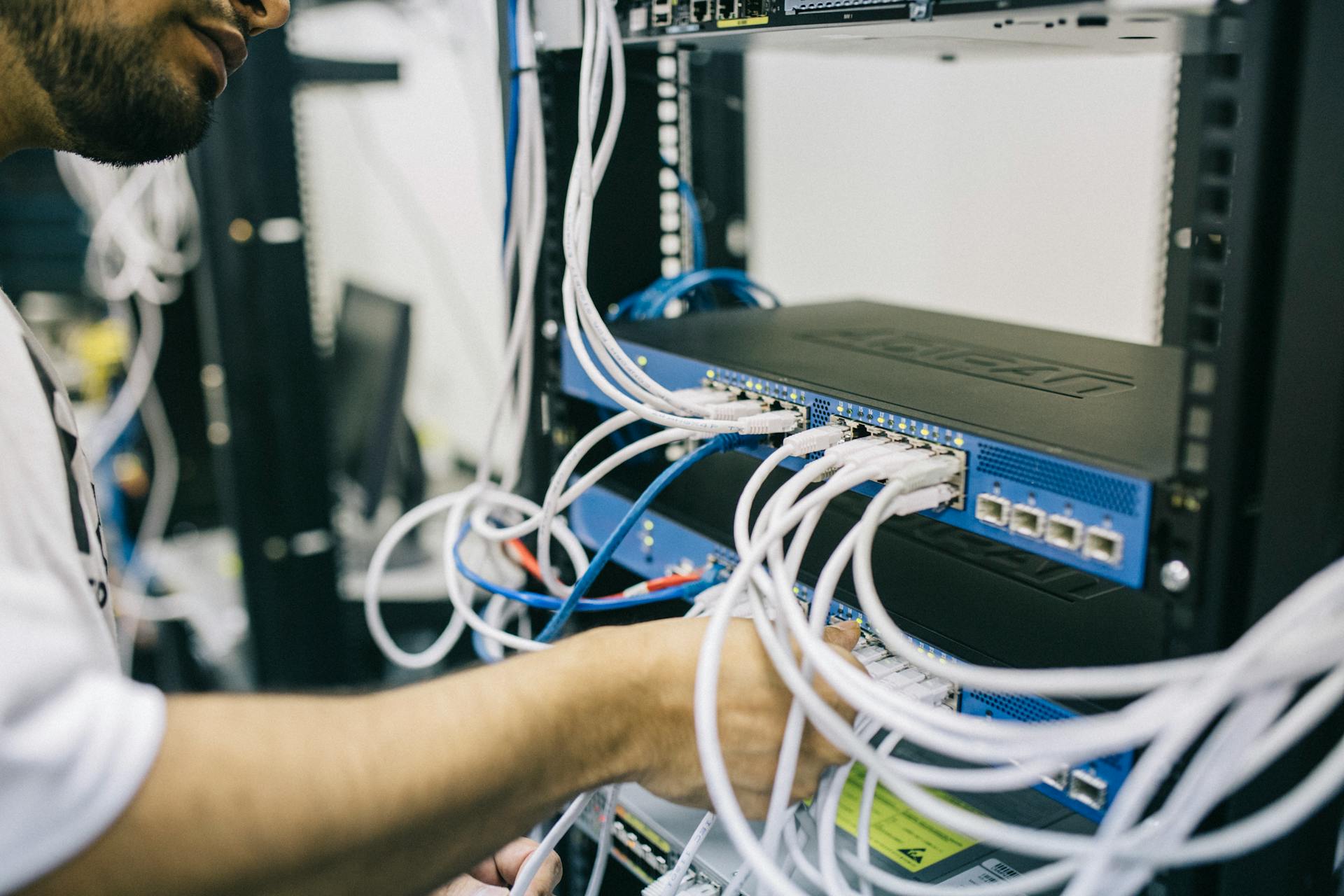
To determine if you're PCI compliant, you'll need to undergo a regular audit to ensure you're meeting the standards. This audit will assess your payment card data handling and storage processes.
The PCI Security Standards Council (PCI SSC) provides a set of guidelines and requirements to help you achieve compliance. You'll need to implement these standards across your entire organization, not just in specific departments.
As part of the PCI compliance process, you'll need to complete a Self-Assessment Questionnaire (SAQ) to evaluate your compliance level. The SAQ will ask you a series of questions about your payment card data handling and storage practices.
By following the PCI SSC guidelines and completing the SAQ, you'll be well on your way to achieving PCI compliance and protecting your customers' sensitive payment information.
Explore further: How Do I Know If I Need a Filling?
Understanding PCI Compliance
PCI compliance isn't just a one-time task, it's an annual requirement. You need to complete the assessment questionnaire each year to ensure you're meeting the necessary standards.
To determine your PCI compliance level, you need to consider the number of card transactions your business processes. This will help you understand which requirements apply to you.
There are four merchant levels, which vary slightly by card network. For example, Visa classifies Level 4 merchants as those that process fewer than 20,000 online card transactions or up to 1 million total transactions per year.
Here's a breakdown of the four merchant levels:
Larger businesses generally have more burdensome requirements, and may need to hire third-party auditors to assess them. Merchants that have had a hack or cyber attack that led to data loss may be moved to a higher validation level by Visa.
Meeting PCI Requirements
To be PCI compliant, you must meet the 12 core requirements designed to protect cardholder data wherever it is transmitted or stored. This includes installing and maintaining a firewall, changing vendor-supplied default passwords and security settings, and encrypting cardholder data when transmitting it across open, public networks.
Expand your knowledge: First Data Pci Compliance
You should also use and regularly update antivirus software, and develop security systems and processes to find and take action on vulnerabilities. Restrict access to cardholder data to a need-to-know basis, and assign user IDs to everybody with computer access.
To become PCI compliant, small businesses typically must fill out a self-assessment form, while larger businesses usually need to hire third-party auditors to assess them. You must also complete a quarterly scan of your systems if you process more than 1 million transactions per year or more than 20,000 online transactions per year.
Here are the 4 compliance levels, broken out by how many transactions the merchant processes each year:
You should also have a security policy for your business that addresses all aspects of the PCI DSS, and regularly test systems and processes to ensure they are secure.
Becoming PCI Compliant
To become PCI compliant, small businesses typically fill out a self-assessment form, while larger businesses may need to hire third-party auditors and submit additional paperwork. These businesses may also have to hire an outside firm to scan their networks.
The PCI compliance requirement is universal, but validation requirements and assessments may vary depending on the card network. For example, Visa has four compliance levels based on the volume of card transactions.
Here's a breakdown of the Visa compliance levels:
Merchants that have had a hack or cyber attack may be moved to a higher validation level by Visa.
Becoming Compliant
Becoming PCI compliant requires meeting specific requirements, which vary depending on the number of transactions processed annually. To determine which level you fall under, consider the following breakdown: Level 1 merchants process over 6 million transactions, Level 2 merchants process between 1-6 million transactions, Level 3 merchants process between 20,000-1 million transactions, and Level 4 merchants process less than 20,000 transactions.
To achieve compliance, small businesses typically fill out a self-assessment form, while larger businesses may need to hire third-party auditors. These businesses may also have to submit additional paperwork and hire an outside firm to scan their networks.
Intriguing read: Pci Dss Compliant Level 1
The type of annual assessment required depends on the card network and the volume of card transactions. Merchants that have had a hack or cyber attack that led to data loss may be moved to a higher validation level by Visa.
To simplify the process, consider the following steps:
- Complete the relevant PCI DSS Self Assessment Questionnaire (SAQ) based on your merchant level.
- Pass a vulnerability scan with a PCI SSC Approved Scanning Vendor (ASV).
- Submit the Attestation of Compliance (AOC) to your acquirer.
Each level will require merchants to complete the relevant SAQ, which provides evidence that the merchant has completed and passed a vulnerability scan and submitted the AOC.
The following table summarizes the merchant levels and their corresponding requirements:
Keep in mind that these requirements are subject to change, and it's essential to check with your card network for the most up-to-date information.
Frequently Asked Questions
P2PE is a game-changer for merchants, making account data unreadable by unauthorized parties and protecting customer data, which in turn safeguards a company's reputation.
By using a PCI-validated P2PE solution, merchants can simplify compliance efforts with the PCI DSS requirements.
A different take: Card Data Covered by Pci Dss Includes
A P2PE solution has four key benefits:
- Makes account data unreadable by unauthorized parties and protects customer data and therefore a company's reputation
- “De-values” account data because it can’t be decrypted even if stolen
- Simplifies compliance with PCI DSS requirements
- Reduces the P2PE Self-Assessment Questionnaire to only 26 requirements
To use the SAQ P2PE-HW, merchants must confirm they're using a P2PE solution listed on the PCI SSC’s List of Validated P2PE Solutions.
Merchants using SAQ P2PE-HW must not store, process, or transmit any cardholder data on any system or electronic media outside of the payment terminal used as part of the P2PE solution.
Merchants must also verify that there is no legacy storage of cardholder data from other payment devices or systems.
By implementing all controls in the P2PE Instruction Manual (PIM) provided by the P2PE Solution Provider, merchants can ensure they're meeting the necessary requirements.
Independent Software Vendors (ISVs) can remove their respective application from PCI scope as long as their solution is integrated with CardConnect's P2PE solution.
Broaden your view: Pci Dss P2pe
PCI Compliance Process
To become PCI compliant, small businesses typically need to fill out a self-assessment form, while larger businesses usually require third-party auditors to assess them.
The PCI compliance requirement is universal, but validation requirements and assessments may vary slightly depending on the card network. This means that the type of annual assessment required will depend on the volume of card transactions.
A business falls into one of four category levels, which determine the compliance requirements. For example, Visa has four levels of compliance: Level 1 merchants process over 6 million transactions per year, while Level 4 merchants process fewer than 20,000 e-commerce transactions.
Here's a breakdown of the four merchant levels, as determined by Visa:
If a business experiences a hack or cyber attack that leads to data loss, it may be moved to a higher validation level by Visa.
Security Measures
To ensure you're PCI compliant, it's essential to implement robust security measures. Firewalls are a must-have, as they block unauthorized access to private data, serving as the frontline defense against hackers.
Regular vulnerability tests are also crucial, as they help identify potential weaknesses and prevent data breaches. You should scan for vulnerabilities regularly, just like you would change your car's oil to keep it running smoothly.
Protecting passwords is another key aspect of PCI compliance. Use unique security measures and customize passwords to prevent public access. Keep a list of all software and devices that require passwords, along with their basic configurations, to ensure you're not leaving any vulnerabilities behind.
Additional reading: Pci Dss Information Security Policy
Run Security Tests
Running security tests is a crucial part of maintaining the integrity of your data. This should be done frequently to identify potential vulnerabilities and threats.
Regular scanning of vulnerability tests is essential to prevent malfunctions and ensure the security of your systems. This is especially important when dealing with different software, locations, and employees.
Firewalls are a key component in preventing unauthorized access to your data, and they should be seen as the frontline of defense against hackers. They are required for PCI DSS compliance.
Encrypting cardholder data is also a critical step in securing your systems. This includes encrypting data with certain algorithms and using encryption keys, as well as scanning PAN to ensure no unencrypted data exists.
Cardholder data should be encrypted when transmitted across public networks, and account numbers should never be shared or sent to unknown locations. This is a fundamental aspect of PCI DSS compliance.
Discover more: How Do You Know When Oil Is Ready?
Password Protection and Security Measures
Protecting your passwords is crucial, and it starts with customization. Default passwords on modems and routers are easily accessible to the public.
Keeping a list of all software and devices that require passwords is a good idea. This inventory should also include basic configurations, such as changing the original password.
Many businesses fail to secure vulnerabilities in third-party products. Modems, routers, POS systems, and other devices often come with generic passwords and standard security measures.
Changing the original password on these devices is a simple step to take. It's a good practice to update your passwords regularly to stay secure.
By taking these precautions, you can ensure compliance and protect your passwords from unauthorized access.
Payment Processors and PCI
If you're a business owner, you'll need a payment processor to accept card payments, and they'll often handle PCI compliance for you.
Merchant account providers or payment service providers are the ones who help you accept card payments, and they usually include specific PCI compliance-related requirements in their contracts.
Suggestion: Pci Compliant Payment Processors
It's essential to talk to your payment processor about the specific compliance requirements in your contract.
They may also have consultant recommendations or provide compliance services, so be sure to ask about those.
You might be paying a PCI compliance fee, so it's good to know if that's the case.
If you're looking for a PCI-compliant payment processor, check out NerdWallet's list of top credit card processing companies.
Here are some questions to ask your payment processor:
- What specific compliance requirements are in my contract?
- Do you offer consultant recommendations or compliance services?
- Am I paying a PCI compliance fee?
- What other compliance services do you provide or recommend?
PCI Compliance Levels
To determine your PCI compliance level, you'll need to consider the number of transactions your business processes each year. The level of compliance depends on this volume, with larger businesses processing more transactions requiring more rigorous validation.
There are four levels of PCI compliance, and your business will fall into one of these categories based on your transaction volume. Level 1 merchants process over 6 million transactions per year, while Level 2 merchants process between 1-6 million transactions annually.
A unique perspective: Pci Dss Level 4
For most small businesses, the compliance level is Level 4, which applies to those processing fewer than 20,000 card transactions per year. This includes businesses with fewer than 1 million transactions annually, and those with fewer than 20,000 e-commerce transactions.
Here are the four PCI compliance levels in a nutshell:
Businesses that experience a hack or cyber attack may be moved to a higher validation level, even if they previously met the requirements for a lower level.
PCI Compliance Costs and Benefits
PCI compliance costs can be a significant consideration for businesses. Some payment processors charge annual fees for PCI compliance, which can range from $79.95 to $0.
National Processing charges a $79.95 annual fee for PCI compliance, while Dharma Merchant Services charges a $39.95 monthly fee for noncompliance. On the other hand, Adyen, Payline, Square, and Stripe don't have specific charges for PCI compliance.
Becoming PCI compliant usually costs something, even if your payment partner doesn't charge a fee. Level 4 merchants can expect to pay hundreds of dollars annually to hire an approved scanning vendor.
Explore further: Pci Compliance Fee
Some payment processors don't have any information listed on their website about PCI compliance fees, or they may have vague "service fees" that may or may not include PCI-related items.
Here's a breakdown of the PCI compliance fees charged by some payment processors:
Frequently Asked Questions
What happens if I'm not PCI compliant?
Non-compliance can result in significant financial penalties, ranging from $5,000 to $100,000 per month, as well as damage to your reputation and revenue loss. If you're not PCI compliant, you may face severe consequences that can impact your business.
Sources
- https://www.nerdwallet.com/article/small-business/pci-compliance
- https://www.weareplanet.com/blog/what-is-pci-compliance
- https://www.verygoodsecurity.com/blog/posts/what-is-pci-compliance
- https://paysimple.com/blog/pci-compliance-requirements-for-small-businesses/
- https://www.cardconnect.com/launchpointe/payment-security/pci-compliance-101/
Featured Images: pexels.com


